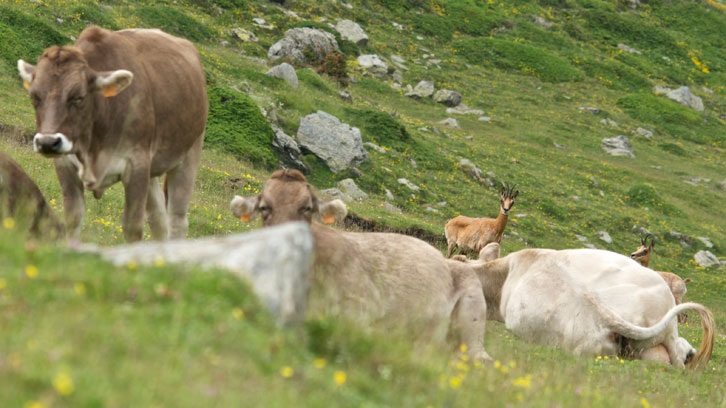Q Fever in domestic and wild ruminants from the Pyrenees

Q Fever is a disease that can be severe for humans. It is caused by Coxiella burnetii infection and cattle, goats and sheep are considered its main reservoir, but it and can also be found in wild ruminants. Jorge Ramón López Olvera, from the Servicio de Ecopatología de Fauna Salvaje, brings us to the study carried out to determine the presence of this bacteria in animals from the Catalan Pyrenees.
Coxiella burnetii is a common and worldwide spread intracellular bacteria which can infect a wide variety of hosts, causing a disease named Q Fever that can be severe for humans. Severe human outbreaks of this disease have occurred in Europe in the last years, and as a consequence Q Fever has earned relevance for public health. Although it is not a frequent disease for humans in Spain, it is more important in the northern regions.
Cattle, goats and sheep are considered the main reservoir of the disease, but there is not much information about the role wild hosts may play in the maintenance or dispersal of the bacteria. On the other hand, the relationship among domestic and wild ruminants may have an effect on C. burnetii transmission, with repercussions for public health in game and livestock areas.
In order to unveil the relative relevance of wild and domestic ruminants in the ecology of C. burnetii in the Catalan Pyrenees, the Servicio de Ecopatología de Fauna Salvaje (SEFaS) of the UAB has carried out a serological study. Serum samples from wild ruminants (chamois, roe deer, red deer, fallow deer and mouflon) and domestic ruminants (cow, sheep and goat) sharing summer pastures with wild ruminants were collected and analyzed during a five-year period.
Antibodies against C. burnetti were detected in sheep, mouflons, red deer and cows, in decreasing order of relevance, although the scenario varies depending on the area of study and the livestock flock sampled. Sheep was the only species showing antibodies against C. burnetti in all the study areas, reaching higher values than the other species except for mouflon. These differences suggest that sheep likely has a more important role in the ecology and transmission of C. burnetti in the Catalan Pyrenees then the other species studied. The low exposition to C. burnetti in wild ruminants indicates that none of these species acts as a single reservoir host, but probably participate in epidemiological cycles which include other hosts, as for example rodents.
It is advisable that the human sectors in contact with the studied species (hunters, farmers,...) adopt prophylactic measures to avoid C. burnetti infection, particularly during game meat manipulation or in case of abortions in domestic ruminants.
Cattle, goats and sheep are considered the main reservoir of the disease, but there is not much information about the role wild hosts may play in the maintenance or dispersal of the bacteria. On the other hand, the relationship among domestic and wild ruminants may have an effect on C. burnetii transmission, with repercussions for public health in game and livestock areas.
In order to unveil the relative relevance of wild and domestic ruminants in the ecology of C. burnetii in the Catalan Pyrenees, the Servicio de Ecopatología de Fauna Salvaje (SEFaS) of the UAB has carried out a serological study. Serum samples from wild ruminants (chamois, roe deer, red deer, fallow deer and mouflon) and domestic ruminants (cow, sheep and goat) sharing summer pastures with wild ruminants were collected and analyzed during a five-year period.
Antibodies against C. burnetti were detected in sheep, mouflons, red deer and cows, in decreasing order of relevance, although the scenario varies depending on the area of study and the livestock flock sampled. Sheep was the only species showing antibodies against C. burnetti in all the study areas, reaching higher values than the other species except for mouflon. These differences suggest that sheep likely has a more important role in the ecology and transmission of C. burnetti in the Catalan Pyrenees then the other species studied. The low exposition to C. burnetti in wild ruminants indicates that none of these species acts as a single reservoir host, but probably participate in epidemiological cycles which include other hosts, as for example rodents.
It is advisable that the human sectors in contact with the studied species (hunters, farmers,...) adopt prophylactic measures to avoid C. burnetti infection, particularly during game meat manipulation or in case of abortions in domestic ruminants.
Xavier Fernández‑Aguilar, Óscar Cabezón, Andreu Colom‑Cadena, Santiago Lavín, Jorge Ramón López‑Olvera
Animal Medicine and Surgery Department
References
Fernández-Aguilar X, Cabezón Ó, Colom-Cadena A, Lavín S, López-Olvera JR. Serological survey of Coxiella burnetii at the wildlife–livestock interface in the Eastern Pyrenees, Spain. Acta Veterinaria Scandinavica. 2015;58:26. doi:10.1186/s13028-016-0209-4.


